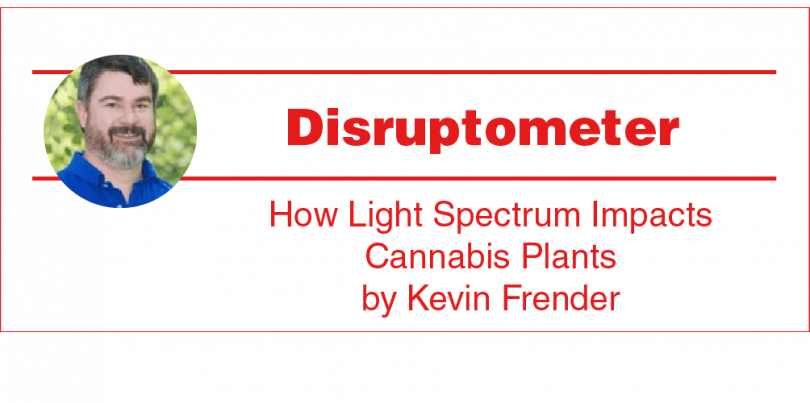The importance of light for indoor cannabis cultivation cannot be understated; without light, plants simply won’t grow! While a wide variety of light types will grow plants, some work vastly better than others for plant growth, due to both spectrum and intensity. By tailoring the light intensity and spectrum to what plants want, growers can maximize yield and quality while minimizing running costs.
Many people don’t realize that human eyes and plants have vastly different needs for light. Human eyes are most sensitive to green and yellow light, while chlorophyll (the pigments in plants responsible for photosynthesis) absorb primarily blue and red light (Figure 1). In fact, plants reflect more of the green light that hits their leaves than any other color. This is why they look green to us.
Figure 1.
It isn’t that plants can’t grow with yellow or green light; high-pressure sodium (HPS) lights long used for agriculture put out primarily yellow light, but it is less efficient at driving photosynthesis. Accessory protein pigments that cluster around chlorophyll capture yellow and green photons and convert them to lower-energy red photons that chlorophyll can absorb, releasing the extra energy in the form of heat. [1] When plants are given primarily yellow light, this extra heating of the leaves forces you to keep ambient temperatures lower to prevent burning the leaves. This is why plants grown under HPS lights will get stressed or die at temperatures above about 85 °F, even though the same plants easily tolerate temperatures over 100 °F outdoors with natural sunlight.
White, so-called “full-spectrum” LEDs have been designed for the human eye, with the spectrum very closely matching the sensitivity of the human eye and putting out primarily yellow and green light to maximize their brightness as perceived by our eyes (Figure 2). This spectral efficiency for humans and LEDs’ inherent energy efficiency has revolutionized architectural lighting; white LEDs are being produced in massive volumes to replace legacy lighting technologies worldwide. The scale of production makes them fairly inexpensive.
Figure 2.
White LEDs also happen to be able to grow plants better than legacy technologies like HPS and metal halide (MH) lights, primarily due to their broader spectrum and better electrical efficiency.
However, as their spectrum was designed to be perfect for human eyes, white LEDs are not the ideal spectrum for growing plants; most of the light is still in the photosynthetically least-efficient green and yellow area of the spectrum. This makes plants grown under white LEDs more prone to heat stress, requiring more air conditioning to keep the plants happy.
In addition, because white LEDs are designed for what the human eye can see, they completely lack colors/wavelengths of light present in natural sunlight that humans can’t see, namely ultraviolet (UV) and infrared (IR), both of which plants use.
Infrared light, specifically 700 nm to 750 nm, increases photosynthesis in plants due to the Emerson Effect, which was first observed in the 1950s. [2] Recent research has shown up to a 35% increase in plant yield by incorporating these wavelengths that are dimly or not visible to human eyes, yet these wavelengths are not counted in the photosynthetically active radiation (PAR) definition of 400-700 nm. [3]
Ultraviolet light below 400 nm also can drive photosynthesis, but it is of more interest to Cannabis growers due to the effects it has on plant growth. Just as human skin protects itself by producing melanin, a natural sunscreen compound, plants produce natural sunscreen compounds to protect themselves from UV light. In Cannabis plants, these compounds include delta-9-tetrahydrocannabinol, cannabidiol, terpenes, and anthocyanin (a reddish-purple pigment). Trichome production is also increased with exposure to UV light, as these act like little sunshades for the leaf. Plants also grow thicker cell walls with exposure to UV, making them more resistant to viruses, fungi, bacteria, and insects.
By tuning the spectrum of light provided to plants to maximize photosynthetic efficiency (rather than perceived brightness to human eyes), it is possible to get higher yields and healthier plants while simultaneously reducing HVAC operating costs. Further, incorporating wavelengths of light invisible to human eyes — and even outside the official PAR range definition — can substantially increase Cannabis yields and quality at the same time.
References:
[1] Berg JM, Tymoczko JL, Stryer L. Biochemistry. 5th edition. New York: W H Freeman; 2002. Section 19.5, Accessory Pigments Funnel Energy into Reaction Centers. [2] Emerson, R. Dependence of yield of photosynthesis in long-wave red on wavelength and intensity of supplementary light. Science. 1957;125:746-752. [journal impact factor = 41.845; times cited = 99 (Google Scholar)] [3] Zhen S, Bugbee B. Far-red photons have equivalent efficiency to traditional photosynthetic photons: Implications for redefining photosynthetically active radiation. Plant Cell Environ. 2020;43(5):1259-1272. [journal impact factor = 6.362; times cited = 17 (Semantic Scholar)]
Kevin Frender is Chief Science Officer and Chief Technology Officer at Black Dog Grow Technologies. He has been growing indoors with artificial light for more than 35 years, using every commercially available lighting technology along the way. He also starts plants indoors for his summer outdoor garden every year and has decades of experience with hardening-off seedlings for transplantation outdoors. Combined with a vast knowledge of plants and a penchant for science, Frender is an expert in the field of lighting.











